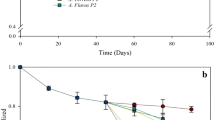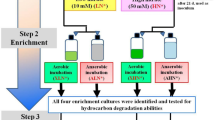Abstract
Background, aim, and scope
Primitive wax refining techniques had resulted in almost 50,000 tonnes of acidic oily sludge (pH 1–3) being accumulated inside the Digboi refinery premises in Assam state, northeast India. A novel yeast species Candida digboiensis TERI ASN6 was obtained that could degrade the acidic petroleum hydrocarbons at pH 3 under laboratory conditions. The aim of this study was to evaluate the degradation potential of this strain under laboratory and field conditions.
Materials and methods
The ability of TERI ASN6 to degrade the hydrocarbons found in the acidic oily sludge was established by gravimetry and gas chromatography–mass spectroscopy. Following this, a feasibility study was done, on site, to study various treatments for the remediation of the acidic sludge. Among the treatments, the application of C. digboiensis TERI ASN6 with nutrients showed the highest degradation of the acidic oily sludge. This treatment was then selected for the full-scale bioremediation study conducted on site, inside the refinery premises.
Results
The novel yeast strain TERI ASN6 could degrade 40 mg of eicosane in 50 ml of minimal salts medium in 10 days and 72% of heneicosane in 192 h at pH 3. The degradation of alkanes yielded monocarboxylic acid intermediates while the polycyclic aromatic hydrocarbon pyrene found in the acidic oily sludge yielded the oxygenated intermediate pyrenol. In the feasibility study, the application of TERI ASN6 with nutrients showed a reduction of solvent extractable total petroleum hydrocarbon (TPH) from 160 to 28.81 g kg−1 soil as compared to a TPH reduction from 183.85 to 151.10 g kg−1 soil in the untreated control in 135 days. The full-scale bioremediation study in a 3,280-m2 area in the refinery showed a reduction of TPH from 184.06 to 7.96 g kg−1 soil in 175 days.
Discussion
Degradation of petroleum hydrocarbons by microbes is a well-known phenomenon, but most microbes are unable to withstand the low pH conditions found in Digboi refinery. The strain C. digboiensis could efficiently degrade the acidic oily sludge on site because of its robust nature, probably acquired by prolonged exposure to the contaminants.
Conclusions
This study establishes the potential of novel yeast strain to bioremediate hydrocarbons at low pH under field conditions.
Recommendations and perspectives
Acidic oily sludge is a potential environmental hazard. The components of the oily sludge are toxic and carcinogenic, and the acidity of the sludge further increases this problem. These results establish that the novel yeast strain C. digboiensis was able to degrade hydrocarbons at low pH and can therefore be used for bioremediating soils that have been contaminated by acidic hydrocarbon wastes generated by other methods as well.



Similar content being viewed by others
References
Atlas RM, Sayler G, Burlage RS, Bej AK (1992) Molecular approaches for environmental monitoring of microorganisms. BioTechniques 12:706–717
Bhattacharya D, Sarma PM, Krishnan S, Mishra S, Lal B (2003) Evaluation of genetic diversity among Pseudomonas citronellolis strains isolated from oily sludge contaminated sites. Appl Environ Microbiol 69:1431–1441
Bossert ID, Compeau GC (1995) Cleanup of petroleum hydrocarbon contamination in soil. In: Young LY, Cerniglia CE (eds) Microbial transformation and degradation of toxic organic chemicals. Petroleum microbiology. MacMillan, New York
Cerniglia CE (1997) Fungal metabolism of polycylic aromatic hydrocarbons: past, present and future applications in bioremediation. J Ind Microbiol Biotech 19:324–333
Dibble JT, Bartha R (1979) Effect of environmental parameters on the biodegradation of oil sludge. Appl Environ Microbiol 55:729–739
Forsyth JV, Tsao YM, Bleam RD (1995) Bioremediation: when is bioaugmentation needed? In: Hinchee RE, Fredrickson J, Alleman BD (eds) Bioaugmentation for site remediation. Battelle, Columbus, pp 1–14
Hao C, Zhang H, Haas R, Bai Z, Zhang B (2007) A novel community of acidophiles in an acid mine drainage sediment. World J Microbiol Biotechnol 23:15–21
Johnson DB, Rolfe S, Hallberg KB, Iversen E (2001) Isolation and phylogenetic characterization of acidophilic microorganisms indigenous to acidic drainage waters at an abandoned Norwegian copper mine. Environ Microbiol 3:630–637
Kloos K, Schloter M, Meyer O (2006) Microbial activity in an acid resin deposit: biodegradation potential and ecotoxicology in an extremely acidic hydrocarbon contamination. Environ Pollut 144:136–144
Küsel K, Roth U, Drake HL (2002) Microbial reduction of Fe(III) in the presence of oxygen under low pH conditions. Environ Microbiol 4:414–421
Layne E (1957) Spectrophotometric and turbidimetric methods for measuring proteins. Methods Enzymol 10:447–455
Mac Gillivray AR, Shiaris MP (1993) Biotransformation of polycyclic aromatic hydrocarbons by yeasts isolated from coastal sediments. Appl Environ Microbiol 59:1613–1618
Maila MP, Cloete TE (2004) Bioremediation through landfarming: are simplicity and cost-effectiveness the only advantages? Rev Environ Sci Biotechnol 3:349–360
Mishra S, Jyot J, Kuhad RC, Lal B (2001) In situ bioremediation potential of an oily sludge degrading bacterial consortium. Curr Microbiol 43:328–335
Prasad GS, Mayilraj S, Sood N, Singh V, Biswas K, Lal B (2005) Candida digboiensis TERI ASN6 sp. nov., a novel anamorphic yeast species from an acidic sludge contaminated oil field. Int J Syst Evol Microbiol 55:967–972
Rowe OF, Sánchez-España J, Hallberg KB, Johnson DB (2007) Microbial communities and geochemical dynamics in an extremely acidic, metal-rich stream at an abandoned sulfide mine (Huelva, Spain) underpinned by two functional primary production systems. Environ Microbiol 9:1761–1771
Sood N, Lal B (2008) Isolation of a novel yeast strain Candida digboiensis TERI ASN6 capable of degrading petroleum hydrocarbons under acidic conditions. J Environ Manag 90:1728–1736. doi:10.1016/j.jenvman.2008.11.026
TEDDY (2006) TEDDY, TERI Energy Data Directory and Yearbook 2004/2005. Project coordinator: Pooja Goel. TERI, New Delhi, p 60
Yuste L, Corbella ME, Turiegano MJ, Karlson U, Puyet A, Rojo F (2000) Characterization of bacterial strains able to grow on high molecular mass residues from crude oil processing. FEMS Microbiol Ecol 32:69–75
Acknowledgments
We are thankful to Dr. R. K. Pachauri, Director General, TERI for providing the infrastructure to carry out the present study and the Department of Biotechnology, Government of India for the financial support to carry out this study. We are grateful to the staff of Assam Oil Division for their help during fieldwork. The authors are grateful to Dr. D. K Tuli and Dr. M. P. Singh of IOCL R&D center for their support. The authors are in gratitude for the help provided by Vikas, Dileep, Akhil, Srivalli, and Neha for their kind help. The authors acknowledge the technical assistance of Abu Swaleh, Vinod, and Rambaran.
Author information
Authors and Affiliations
Corresponding author
Additional information
Responsible editor: Hailong Wang
Electronic supplementary material
Below is the link to the electronic supplementary material.
ESM 1
(DOC 388 kb)
Rights and permissions
About this article
Cite this article
Sood, N., Patle, S. & Lal, B. Bioremediation of acidic oily sludge-contaminated soil by the novel yeast strain Candida digboiensis TERI ASN6. Environ Sci Pollut Res 17, 603–610 (2010). https://doi.org/10.1007/s11356-009-0239-9
Received:
Accepted:
Published:
Issue Date:
DOI: https://doi.org/10.1007/s11356-009-0239-9




